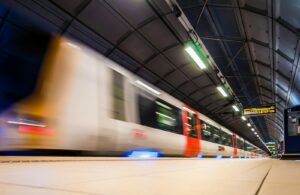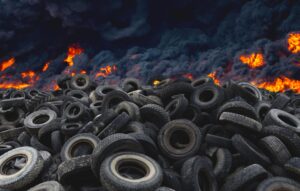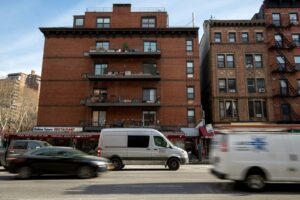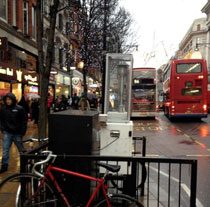Busy shopping street is first in London to breach annual NO2 legal limit, while Oxford St is also thought to have breached
Air pollution on Putney High Street was this morning (January 8) recorded as having breached EU legal limits for the whole of 2016 in little more than a week, with other roads in London also expected to record similar pollution breaches in the coming days.
Situated just south of the River Thames in Putney, the busy shopping road become the first in London to record air pollution limit breaches in 2016, although Oxford Street is also thought to have breached limits and the likes of Knightsbridge, Brixton Road and Marylebone Road are expected to follow suit.
Air quality monitors on Putney High Street recorded the 19th breach of the EU hourly 200ugm3 (microgrammes per cubic metre) limit for nitrogen dioxide (NO2) during today’s morning rush hour, the London Air Quality Network confirmed.
Under EU and UK law, individual air quality monitors are permitted only 18 breaches of the 200ugm3 hourly limit during an entire calendar year.
News of the breach on Putney High Street — a well-known pollution hotspot — comes ahead of a ban on daytime deliveries to shops on the road, which is due to start from Monday (January 11) as part of a pilot Wandsworth council initiative aimed at alleviating traffic pollution (see AirQualityNews.com story).

King’s College London graph showing hourly NO2 levels on Putney High Street (click to enlarge – levels above 200ugm3 count as a breach)
Oxford Street
Last January, NO2 pollution on Oxford Street took just two days to record more than 18 breaches for the whole of 2015 (see AirQualityNews.com story) and is also already thought to have followed Putney High Street in breaching this same limit for 2016.
However, the Oxford Street air pollution monitoring equipment “developed a fault” on Sunday January 3 and is still not back online, according to the London Air Quality Network, meaning there is no publically-accessible data on NO2 levels or possible breaches available for this week at the present time.
King’s College London, which operates the Network, said Westminster city council and the equipment maintainers “are working to rectify this as fast as possible”.
Operated by KCL in partnership with the Greater London Authority, the London Air Quality Network monitors hourly air pollution levels at around 120 sites in London, including the Knightsbridge monitoring site in Kensington, which at the time of writing is currently on 17 breaches for 2016.
KCL said: “While press and public attention focuses on Oxford Street, it is important to note that the majority of main roads in London regularly breach legal values for nitrogen dioxide as illustrated by today’s results from Putney High Street. Five roads breached the objectives within the first month of 2015.”
Pedestrianisation
The news comes as the Mayor confirmed this week he is considering a range of options to improve traffic flow and air quality on Oxford Street, including much-called-for pedestrianisation of the busy shopping hub.
A detailed assessment of the costs and benefits of each option is due to be competed around the middle of this year.
Responding to a question from Lib Dem Assembly Member Stephen Knight this week, the Mayor, Boris Johnson, said Transport for London and Westminster council “are undertaking an assessment of a number of options for enhancing Oxford Street and the surrounding area, including pedestrianising parts of Oxford Street.
“This work will include a detailed assessment of the costs and benefits of each option and this is due to be complete by mid-2016. Once this work has concluded I will make it available for the Assembly and others to consider.
Reaction
Clean Air in London campaigner Simon Birkett said it was “breathtaking that toxic air pollution in London has breached the legal limit for a whole calendar year within a few days. Special thanks to the London Air Quality Network for diligently reporting it.”
Labour MEP for London, Seb Dance, said the news of the breach on Putney High Street would put pressure on government ministers to tackle air pollution ahead of new EU air pollution limits being agreed later this year.
Mr Dance said: “Receiving this dubious accolade has become a depressing annual event for London. NOx kills thousands of Londoners every year, but the government shows no inclination to take proper action.”
And, also commenting today, Clean air lawyer at NGO ClientEarth, Alan Andrews, said: “This is exactly why we are taking the government back to court. Its failure to deal with illegal levels of air pollution, which causes thousands of early deaths in London every year, is a scandal.”
He added: “In the meantime we need to hear from all mayoral candidates about how they are going to solve this public health crisis. Warm words and empty rhetoric won’t save lives.”
Mayor
Responding to this morning’s air pollution limit breaches, a spokesperson for the Mayor of London said: “The Mayor is leading the most ambitious and comprehensive package of measures in the world to improve London’s air quality. His recent £10m bus retrofit programme has led to a sustained reduction in NO2 concentrations on Putney High Street.
“The Mayor expects that by introducing new zero emission capable taxis and the world’s first Ultra Low Emission Zone from 2020, there will be 70 per cent reduction in the number of Wandsworth residents living in areas breaching NO2 limits and significant improvements elsewhere in the capital.”

















